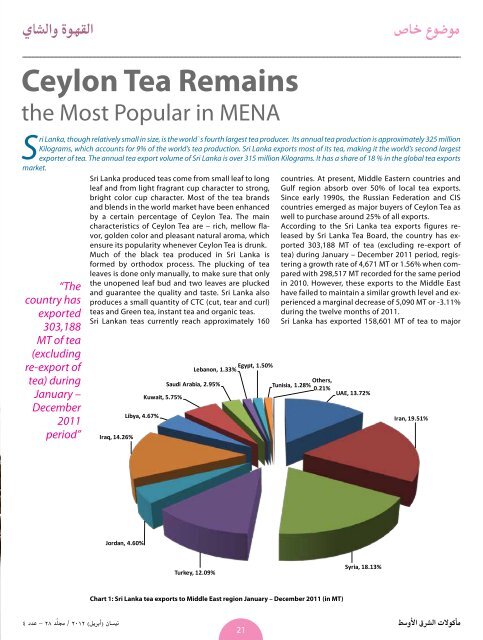articles - Middle East Food (MEF)
articles - Middle East Food (MEF)
articles - Middle East Food (MEF)
Create successful ePaper yourself
Turn your PDF publications into a flip-book with our unique Google optimized e-Paper software.
ياشلاو ةوهقلا صاخ عوضوم<br />
Ceylon Tea Remains<br />
the Most Popular in MENA<br />
Sri Lanka, though relatively small in size, is the world`s fourth largest tea producer. Its annual tea production is approximately 325 million<br />
Kilograms, which accounts for 9% of the world’s tea production. Sri Lanka exports most of its tea, making it the world’s second largest<br />
exporter of tea. The annual tea export volume of Sri Lanka is over 315 million Kilograms. It has a share of 18 % in the global tea exports<br />
market.<br />
“The<br />
country has<br />
exported<br />
303,188<br />
MT of tea<br />
(excluding<br />
re-export of<br />
tea) during<br />
January –<br />
December<br />
2011<br />
period”<br />
Sri Lanka produced teas come from small leaf to long<br />
leaf and from light fragrant cup character to strong,<br />
bright color cup character. Most of the tea brands<br />
and blends in the world market have been enhanced<br />
by a certain percentage of Ceylon Tea. The main<br />
characteristics of Ceylon Tea are – rich, mellow flavor,<br />
golden color and pleasant natural aroma, which<br />
ensure its popularity whenever Ceylon Tea is drunk.<br />
Much of the black tea produced in Sri Lanka is<br />
formed by orthodox process. The plucking of tea<br />
leaves is done only manually, to make sure that only<br />
the unopened leaf bud and two leaves are plucked<br />
and guarantee the quality and taste. Sri Lanka also<br />
produces a small quantity of CTC (cut, tear and curl)<br />
teas and Green tea, instant tea and organic teas.<br />
Sri Lankan teas currently reach approximately 160<br />
Iraq, 14.26%<br />
Libya, 4.67%<br />
Jordan, 4.60%<br />
Kuwait, 5.75%<br />
Saudi Arabia, 2.95%<br />
Egypt, 1.50%<br />
Lebanon, 1.33%<br />
Turkey, 12.09%<br />
countries. At present, <strong>Middle</strong> <strong>East</strong>ern countries and<br />
Gulf region absorb over 50% of local tea exports.<br />
Since early 1990s, the Russian Federation and CIS<br />
countries emerged as major buyers of Ceylon Tea as<br />
well to purchase around 25% of all exports.<br />
According to the Sri Lanka tea exports figures released<br />
by Sri Lanka Tea Board, the country has exported<br />
303,188 MT of tea (excluding re-export of<br />
tea) during January – December 2011 period, registering<br />
a growth rate of 4,671 MT or 1.56% when compared<br />
with 298,517 MT recorded for the same period<br />
in 2010. However, these exports to the <strong>Middle</strong> <strong>East</strong><br />
have failed to maintain a similar growth level and experienced<br />
a marginal decrease of 5,090 MT or -3.11%<br />
during the twelve months of 2011.<br />
Sri Lanka has exported 158,601 MT of tea to major<br />
Tunisia, 1.28% Others,<br />
0.21%<br />
Chart 1: Sri Lanka tea exports to <strong>Middle</strong> <strong>East</strong> region January – December 2011 (in MT)<br />
UAE, 13.72%<br />
Syria, 18.13%<br />
Iran, 19.51%<br />
4 ددع - 28 دّلمج / 2012 )ليربأ( ناسين طسولأا قرشلا تلاوكأم<br />
21




